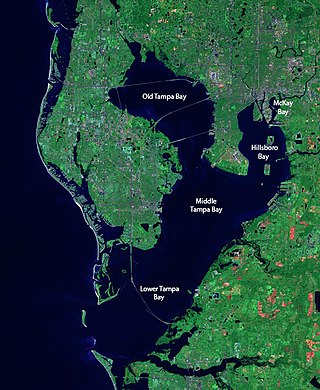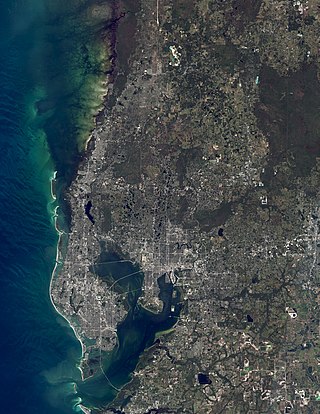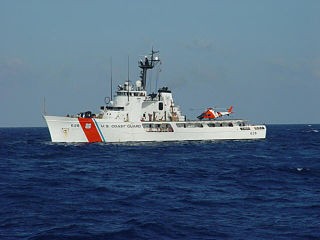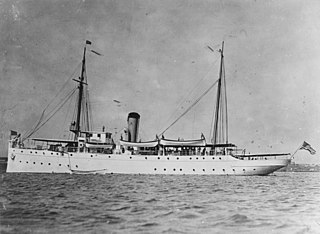
Pinellas County is located on the west central coast of the U.S. state of Florida. As of the 2020 census, the population was 959,107, making it the seventh-most populous county in the state. It is also the most densely populated county in Florida, with 3,491 residents per square mile. The county is part of the Tampa–St. Petersburg–Clearwater Metropolitan Statistical Area. Clearwater is the county seat. St. Petersburg is the largest city in the county, as well as the largest city in Florida that is not a county seat.

St. Petersburg is a city in Pinellas County, Florida, United States. As of the 2020 census, the population was 258,308, making it the fifth-most populous city in Florida and the most populous city in the state that is not a county seat. It is the second-most populous city in the Tampa Bay area, which is the second-largest metropolitan area in Florida with an estimated population of about 3.29 million in 2022.

The Sunshine Skyway Bridge, officially referred to as the Bob Graham Sunshine Skyway Bridge, is a pair of long beam bridges with a central tall cable-stayed bridge. It spans Lower Tampa Bay to connect Pinellas County to Manatee County. The current Sunshine Skyway opened in 1987 and is the second bridge of that name on the site. It was designed by the Figg & Muller Engineering Group and built by the American Bridge Company. The bridge is considered the flagship bridge of Florida and serves as a gateway to Tampa Bay. The four-lane bridge carries Interstate 275 and U.S. Route 19, passing through Pinellas County, Hillsborough County and Manatee County. It is a toll bridge, with a toll assessed on two-axle vehicles traveling in either direction at a rate of $1.75 cash or $1.16 with the state's SunPass system.

Tampa Bay is a large natural harbor and shallow estuary connected to the Gulf of Mexico on the west-central coast of Florida, comprising Hillsborough Bay, McKay Bay, Old Tampa Bay, Middle Tampa Bay, and Lower Tampa Bay. The largest freshwater inflow into the bay is the Hillsborough River, which flows into Hillsborough Bay in downtown Tampa. Many other smaller rivers and streams also flow into Tampa Bay, resulting in a large watershed area.

The Tampa Bay area is a major metropolitan area surrounding Tampa Bay on the Gulf Coast of Florida in the United States. It includes the main cities of Tampa, St. Petersburg, and Clearwater. It is the 17th-largest metropolitan area in the United States, with a population of 3,175,275 as of the 2020 U.S. Census.

Eckerd College is a private liberal arts college in St. Petersburg, Florida, United States. Founded in 1958, part of the campus is waterfront and beach on Boca Ciega Bay. Because of its location, Eckerd is considered a "beach school" and has its own student volunteer maritime search and rescue team. Accredited by the Southern Association of Colleges and Schools, Eckerd is a member of the Annapolis and Oberlin groups of national liberal arts colleges.

The MV Summit Venture was a bulk carrier which collided with the Sunshine Skyway Bridge in 1980, causing a partial collapse of the bridge which killed 35 people.

Interstate 275 (I-275), located in Florida, is a 60-mile-long (97 km) auxiliary Interstate Highway serving the Tampa Bay area. Its southern terminus is at I-75 near Palmetto, where I-275 heads west towards the Sunshine Skyway Bridge crossing over Tampa Bay. From that point, I-275 passes through St. Petersburg before crossing Tampa Bay again on the Howard Frankland Bridge, then continues through the city of Tampa, where it connects to an interchange with I-4 in Downtown Tampa. After the interchange, I-275 passes north through the Tampa suburbs to its northern terminus at I-75 in Wesley Chapel.

United States Coast Guard Air Station Clearwater is the United States Coast Guard's largest air station. It is located at the St. Petersburg-Clearwater International Airport in Clearwater, Florida and is home to nearly 700 USCG aviation and support personnel. As of March 2021, there are ten MH-60T Jayhawk helicopters and four HC-130H Hercules aircraft assigned to CGAS Clearwater. Also on static display is USCG 1023, a restored Grumman HU-16 Albatross.

USCGC Blackthorn (WLB-391) was a 180-foot (55 m) seagoing buoy tender (WLB) which sank in 1980 in a collision near the Tampa Bay Sunshine Skyway Bridge, resulting in 23 crew member fatalities. An Iris-class vessel, she was built by Marine Ironworks and Shipbuilding Corporation in Duluth, Minnesota. Blackthorn's preliminary design was completed by the United States Lighthouse Service and the final design was produced by Marine Iron and Shipbuilding Corporation in Duluth. On 21 May 1943 the keel was laid, she was launched on 20 July 1943 and commissioned on 27 March 1944. The original cost for the hull and machinery was $876,403.

Albert Whitted Airport is a public airport in St. Petersburg, Pinellas County, Florida, United States. It is on the west edge of Tampa Bay, just southeast of downtown St. Petersburg and east of the University of South Florida St. Petersburg.

USCGC Resolute (WMEC-620) is a United States Coast Guard medium endurance cutter.

USCGC Venturous (WMEC-625) is a United States Coast Guard medium endurance cutter. The vessel was constructed by the American Shipbuilding Company in Lorain, Ohio in 1967 and commissioned in 1968. The ship has served on both the west and eastern coasts of the United States. The vessel is used for search and rescue, fishery law enforcement, border enforcement and smuggling interdiction along the coasts and in the Caribbean Sea.

USCGC Durable (WMEC-628) was a United States Coast Guard medium endurance cutter. The Durable was the first cutter in Coast Guard history to hold this name. Like all ships in the Reliance-Class of 210-foot (64 m) medium endurance cutters, Durable was named for an aspirational trait meaning to be capable of withstanding wear or decay.

USCGC Tallapoosa (WPG-52) was a United States Coast Guard cutter of the Tallapoosa-class and was designed to replace the revenue cutter Winona. Her hull was reinforced for light icebreaking. She was initially stationed at Mobile, Alabama, with cruising grounds to Lake Pontchartrain, Louisiana, and Fowey Rocks, Florida. During World War I she escorted convoys out of Halifax, Nova Scotia. After the war she served with the Bering Sea Patrol before returning to Savannah, Georgia, before World War II. During the war Tallapoosa assisted with convoy escort duty and anti-submarine patrols.

USCGC Tampa (ex-Miami) was a Miami-class cutter that initially served in the U.S. Revenue Cutter Service, followed by service in the U.S. Coast Guard and the U.S. Navy. Tampa was used extensively on the International Ice Patrol and also during the Gasparilla Carnival at Tampa, Florida and other regattas as a patrol vessel. It was sunk with the highest American naval combat casualty loss in World War I.
USCGC Point Swift (WPB-82312) was an 82-foot (25 m) Point-class cutter constructed at the Coast Guard Yard at Curtis Bay, Baltimore in 1961 for use as a law enforcement and search and rescue patrol boat. Since the Coast Guard policy in 1961 was not to name cutters under 100 feet (30 m) in length, it was designated as WPB-82312 when commissioned and acquired the name Point Swift in January 1964 when the Coast Guard started naming all cutters longer than 65 feet (20 m).
USCGC Cape Horn was a 95-foot (29 m) type "C" Cape-class cutter constructed at the Coast Guard Yard at Curtis Bay, Maryland, in 1958 for use as a law enforcement and search and rescue patrol boat.
The following is a timeline of the history of the city of St. Petersburg in Pinellas County, Florida, United States.

USS YF-416 was an American YF-257-class covered lighter built in 1943 for service in World War II. She was later acquired by the United States Coast Guard and renamed USCGC White Sumac (WAGL-540).

















